| The Moon - Phases |
| HOME Best Lunar Planets Deepsky Misc Equipment Techniques Links |
| Whole Moons Details Miscellaneous Eclipse 2004 Eclipse 2007 |
| This page contains images of the whole moon at various phases during the lunar cycle. Most of these images are mosaics of a number of individual frames. Click the images to see full-sized ones. |
17 June 2005, 10-day moon mosaic
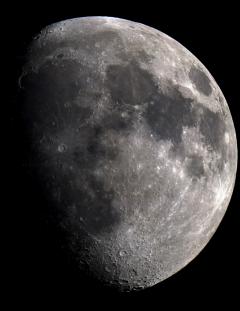
|
Here is a mosaic of the 10-day moon. Despite the very low altitude of the moon at this time of the year the seeing was good enough to result in a very good image. I merged 18 pieces using iMerge. Each was 140 frames chosen from 300 I captured using my Toucam pro with a 2x barlow and Baader UV-IR filter, on the Europa 250.
Each piece of the mosaic was stacked in Registax and light wavelets applied, then into iMerge to create the mosaic. No further processing was required. Click the image to see a larger picture, or click HERE to see the full-sized image. |
| to top | home |
22 May 2005, 13.75-day moon with DSLR
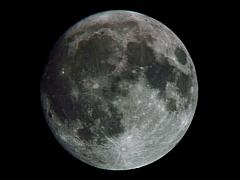
|
Around midnight on 22 May 2005, I noticed the bright, almost-full, moon
and managed a quick imaging session. I used the Canon EOS 300D with my ST80 f/5 refractor, plus 2x Barlow. I stacked 41 shots at 1/100s exposure with the camera set to ISO 100. K3CCDTools was used for stacking, and The Gimp for post-processing.
|
| to top | home |
19 May 2005, Conjunction of the Moon and Jupiter
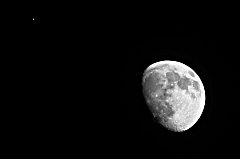
|
On 19 May 2005 the moon passed close by the planet Jupiter, and for a time the sky cleared, enabling me to take a couple of pictures. The image here was captured using my Canon EOS 300D digital SLR camera with an 80-200mm lens set to 200mm. The camera was on fully automatic exposure and aperture for this image. The actual settings used were: ISO 100, 1/60sec exposure, aperture f/5.6. I improved the contrast and sharpness using The Gimp.
I captured another image with the camera on manual settings. This image can be seen HERE For this image the camera was left on ISO 800 (from last time I used it) and I chose an aperture of f/5.6 and an exposure time of 1/640 sec. Contrast the short exposure time at ISO 800 with the much longer one at ISO 100 above! |
| to top | home |
13 May 2005, 5-day Crescent
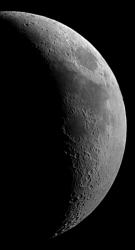
|
This image shows the moon 5 days after new. The eastern Maria can be seen including Mare Crisium towards the top right of the picture, Mare Fecunditatis south and slightly west of it, and further south-west still, Mare Nectaris is clearly defined in the shadows, its western edge just protuding into the dark terminator. North of Mare Nectaris and north-west of Mare Nectaris is Mare Tranquilitatis, the famous Sea of Tranquility, which is only partially visible at this stage in the lunar cycle.
Most of the southern half of this picture is filled with highland craters - this part of the moon is a very busy one. South of Mare Nectaris can clearly be seen the round crater Piccolomini, with a central mountain showing up in the middle of the crater, and leading off into the shadows in the west is the curved chain of the Rupes Altai ridge, a mountainous arc more-or-less concentric with Mare Nectaris and perhaps indicating the edge of a larger basin. Further south still is the large, old crater Janssen, with Fabricus perched on its north-east edge and Metius adjoining in the direction of the Rheita valley (Vallis Rheita), shown as a dark line on this picture. Finally south-west of Janssen can be seen a promenent trio of Hommel, Pitiscus, and Vlacq making a "Mickey mouse" head shape! This picture is a mosaic constructed from only 4 individual images. Each is around 100-200 frames stacked, depending on how many usable frames I had. This picture was shot in poor conditions with a lot of cloud which meant that the far north parts are of worse quality, and in fact I missed the final piece of the mosaic (top left point of the crescent). They were captured using the ToUCam Pro at prime focus of the Europa 250 using a red filter to enhance contrast. Frames were stacked in Registax 3 then merged in iMerge. The resulting mosaic was sharpened in Registax and The Gimp. |
| to top | home |
10 May 2005, 2-day, 9 hours waxing crescent
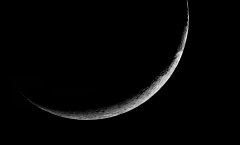
|
Here the moon is shown when it is 2 days and 9 hours after new moon, approximately the same age as the Earthshine picture from 10 March below. At this age only a few features of the moon can be seen well, and the contrast is low because of the still-bright sky at the time the picture was taken.
This picture is a mosaic constructed from 6 individual images. Each of them is a stack of 150 frames (selected from 300). They were captured using the ToUCam Pro at prime focus of the Europa 250 using a red filter to enhance contrast. Frames were stacked in Registax 3 then merged in iMerge. The resulting mosaic was sharpened in Registax and The Gimp. Because the sky was still getting darker at the time the pictures were captured, the pieces of the mosaic didn't match each other in brightness. It was necessary to adjust the brightness of the stacked images using the Levels tool in The Gimp before assembling the final mosaic. |
| to top | home |
18 April 2005, Big 9-day moon mosaic
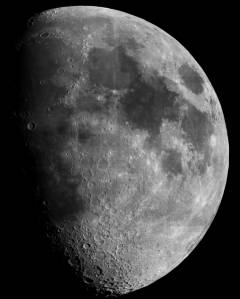
|
On 18 April I decided to capture a large number of high-resolution images to make a high-quality mosaic. I used a 2x Barlow lens to double the magnification and there were 104 AVIs in the final version (I like a lot of overlap!) captured at a focal length of 2400 (Europa 250 plus 2x Barlow) with a red filter. Each AVI had between 90-180 frames stacked in Registax 3. Mosaic was done in iMerge. Post processing in The Gimp.
Unfortunately, after all the work (100 AVIs) the mosaic overlaps are evident in some places and despite trying to get lots of overlap, I missed a few bits (due to drift in DEC) and there were a few holes I had to patch. However the detail is there and it's definitely one of the best moon pictures I have created. |
| to top | home |
10 April 2005, Earthshine on 2-day-old moon
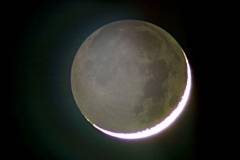
|
This picture shows the effect of the unlit part of the bright crescent moon when it is illuminated by moonlight reflected back from the Earth. This light, known as "Earthshine", can only be seen when the brightly illuminated portion of the moon is a small crescent, as in this 2-day picture. The crescent is overexposed in order that the dim earthshine can be seen
This picture is a single frame captured with a Canon EOS 300D digital SLR camera attached via a Barlow lens to my 80mm f/5.0 refractor. Levels were adjusted and sharpening applied in Pleiades PixInsight-LE and The Gimp. |
| to top | home |
25 March 2005, Full Moon
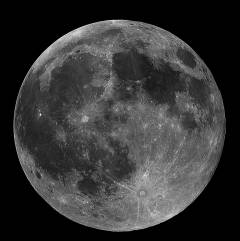
|
This picture shows the full moon captured as a mosaic of 30 pieces. Each was a stack of the best 40 frames chosen automatically from 145. The frames were captured at prime focus of the Europa 250 f/4.8 Newtonian, with the ToUCam Pro. I used Baader UV-IR blocker and contrast booster filters to help with the quality of the image.
Each AVI was aligned and stacked in Registax 3. No resampling was used because I found it to cause grid or horizontal line artifacts, depending on the resampling algorithm used. The stacked images were composed into the full moon mosaic in iMerge, then the whole image was saved and imported into Registax again for wavelet sharpening. Only light wavelets were applied, then The Gimp was used for small colour adjustments and unsharp mask applied. Click the image for a full-screen image, or here for the full sized image (as captured). |
| to top | home |
25 October 2004, 12 days old
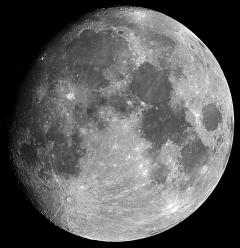
|
The day after the mosaic below, this was captured using the same equipment as the previous one. It turned out to be one of my best and sharpest moon mosaics, possibly because the sub-images were not captured in "drift mode", but, like the previous day's mosaic, with the camera steady and capturing a number of frames that were stacked before mosaicing.
This is comprised of 13 images, each around 70 frames, merged in iMerge. Click the image for a larger picture. |
| to top | home |
24 October 2004, 11 days old
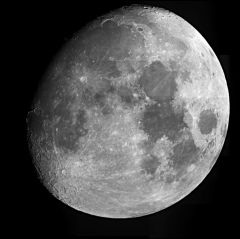
|
This mosaic was captured using my ToUCam Pro, which I prefer for lunar and planetary images. It was at prime focus of the 216mm f/5 Newtonian. This is comprised of 17 images, each around 70 frames, merged in iMerge. Despite auto-brighten and feathering, some evidence of the mosaic can be seen -- I'm not sure why. Nevertheless I am pleased with this one.
Of note in this image, and the following day's one, is that libration (the moon's "wobble") shows us more of the eastern side. Notice how far the Mare Crisium is from the limb, and how rounded it appears, as compared with the images from March and April 2004 when it was closer to the edge of the visible moon and much more foreshortened. In fact, these October images show several prominant features not visible on those earlier pictures. Click the image for a larger picture. |
| to top | home |
4 September 2004, 19 days old
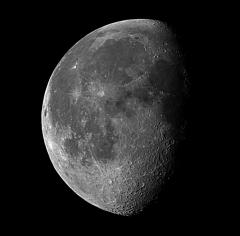
|
This image is another mosaic taken with the Quickcam 3000, at prime focus of the 216mm f/5 Newtonian. Here the moon is a waning gibbous phase, rising later in the evening. Click the image for a large picture, or HERE for a smaller one. |
| to top | home |
1 September 2004, 16 day old moon
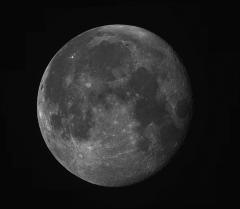
|
The moon is just after full phase in this iMerge mosaic, captured at prime focus of my 216mm f/5 telescope with the QuickCam 3000. Click the image for large picture, or HERE for a smaller one. |
| to top | home |
22 May 2004, 3-day moon
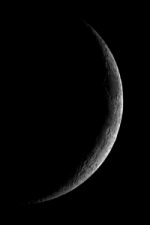
|
Another slim crescent, 3 days and 7 hours after new. This one was taken under better conditions and its greater size meant it was brighter than the previous day's crescent. Also I used a Barlow lens to capture greater detail. The Mare Crisium is completely visible and the craters in the previous image are much clearer. |
| to top | home |
21 May 2004, 2-day moon
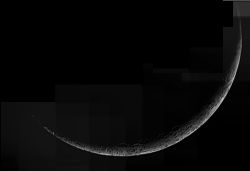
|
My earliest crescent mosaic! This image was captured just 2 days and 9 hours after new moon. Conditions were difficult as the sky was not fully dark and part had to be patched in from earlier in the day when the sky was lighter -- unfortunately the mosaic effect shows up clearly in parts. However it is pleasing to capture such an early moon and several craters can be clearly seen, the largest of which are: Funerius, Hase, and Petavius from left to right in shadow in the lower centre of the picture, Vendelinus and Langrenus further round, and the edge of Mare Crisium. |
| to top | home |
5 April 2004: Full Moon
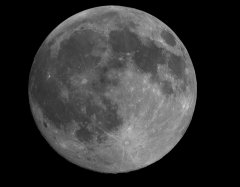
|
Actually the moon was 12 hours before full when I captured this image. It was constructed from 54 frames taken 10 seconds apart and stiched together in iMerge. The final result had wavelets applied in Registax 2 and a little Gaussian blur then unsharp masking in the Gimp, to remove noise. Click the image for an 800x600 version, here for a bigger version, or here for the huge version. |
| to top | home |
29 March 2004: 8-day moon
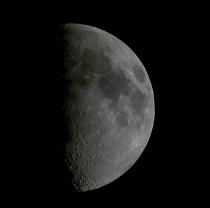
|
Another mosaic, this time made up of 67 individual shots, aligned and merged with iMerge, then enhanced slightly with Registax 2 and the GIMP. On this occasion I turned off the camera's automatic white balance control once it had settled, which avoided the "white-out" at the sunlit edge. Click the picture to the left for the very large version, click here for the slightly smaller version (800x600). |
| to top | home |
27 Feb 2004: 7-day old "half" moon
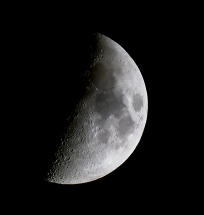
|
This image was created from a mosaic of 43 individual shots, aligned and merged with iMerge, then enhanced slightly with Registax 2. |
| to top | home |
25 Feb 2004: 5-day old Waxing crescent moon
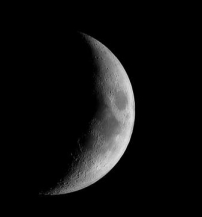
|
This image was created from a mosaic of 34 individual shots, aligned and merged with iMerge, then enhanced slightly with Registax 2 and finally sharpened using The Gimp. |
| to top | home |
 |
|
| All text and images copyright and may not be used without permission |
|